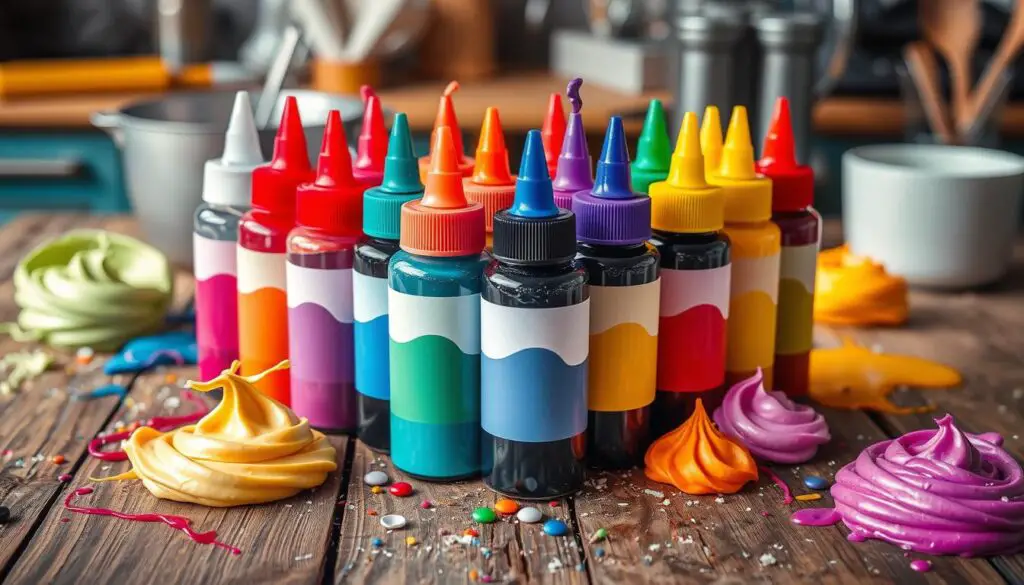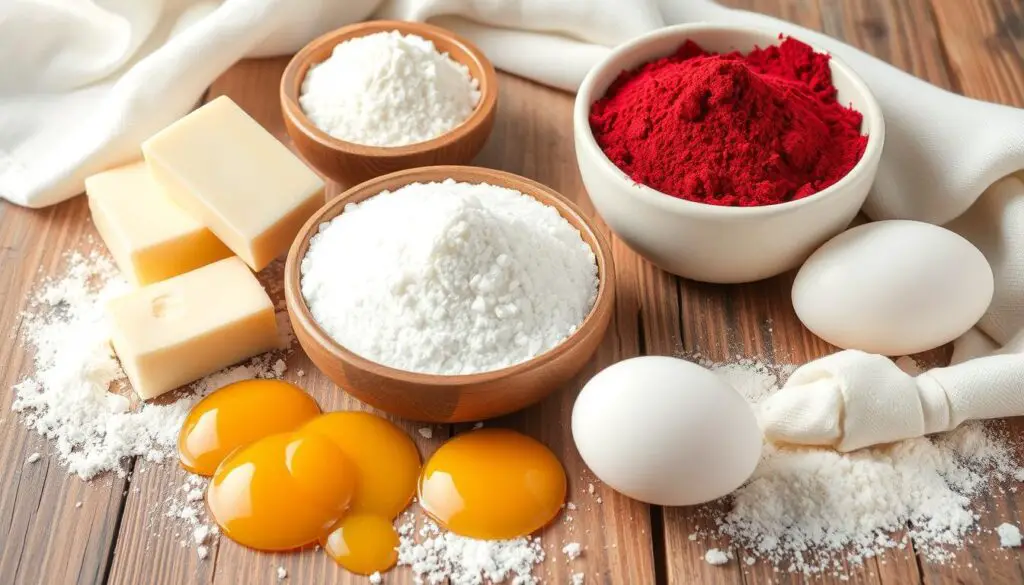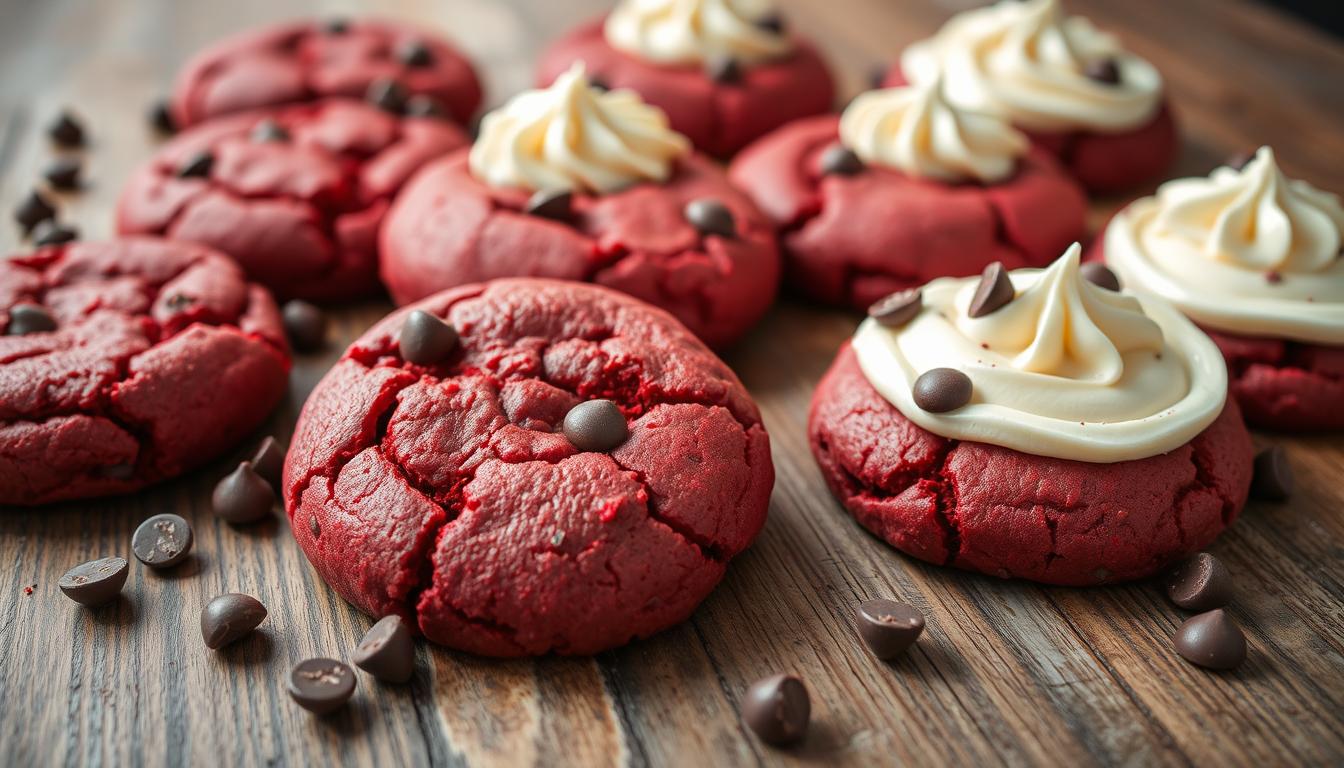As a passionate home baker, nothing can be more disappointing than pulling a batch of vibrant red velvet cookies out of the oven only to find them turned a dull, brownish hue. This common baking conundrum often leaves bakers scratching their heads, wondering what went wrong. But fear not, there are several key factors that can influence the color of your red velvet cookies, and with a little understanding and some tried-and-true techniques, you can achieve the perfect crimson hue every time.
Key Takeaways
- Understand the origin and key ingredients of red velvet cookies to better troubleshoot color issues
- Explore the role of cocoa powder, food coloring, and leavening agents in achieving the desired red velvet color
- Discover how baking temperature, butter, and sugar content can impact the final color of your cookies
- Learn common mistakes to avoid and best practices for storing fresh, vibrant red velvet cookies
- Gain the knowledge to consistently bake show-stopping, perfectly red velvet cookies
Understanding Red Velvet Cookie Color
The red velvet cookie is a timeless classic, known for its vibrant crimson hue that adds a touch of elegance to any dessert spread. But have you ever wondered about the origin of this striking color? Let’s delve into the fascinating history and key ingredients that contribute to the iconic appearance of red velvet cookies.
The Origin of Red Velvet
The rich, velvety red color of red velvet cookies can be traced back to the early 20th century. Originally, the red velvet recipes were made with cocoa powder, which reacted with the acidic buttermilk to create a natural reddish-brown hue. Over time, bakers began experimenting with food coloring to intensify the red color, giving rise to the bold, vibrant shades we associate with red velvet today.
Key Ingredients Affecting Color
- Cocoa Powder: The type and quality of cocoa powder used can significantly impact the color of red velvet cookies. Darker, more alkalized cocoa powders can result in a deeper, richer red tone.
- Food Coloring: The addition of red food coloring is often used to achieve the desired, vivid crimson color in modern red velvet recipes.
- Baking Soda and Baking Powder: The interplay between these leavening agents and the acidic ingredients like buttermilk or vinegar can also influence the final color of the cookies.
- Butter and Sugar: The fat content and sugar levels in the recipe can affect the browning and caramelization of the cookies, potentially impacting the overall color.
By understanding the origins and key ingredients that contribute to the red velvet cookie color, home bakers can better navigate the process of achieving the perfect shade of red in their own creations.
The Role of Cocoa Powder in Red Velvet Cookies
When it comes to baking red velvet cookies, the role of cocoa powder cannot be overstated. This humble ingredient is the key to achieving that signature deep, rich color that makes red velvet cookies so irresistible. But how exactly does cocoa powder impact the color of these delectable treats?
How Cocoa Powder Changes Color
The answer lies in the chemical properties of cocoa powder. During the baking process, the cocoa powder reacts with the acidic ingredients in the dough, such as buttermilk or vinegar, to produce a remarkable color transformation. As the cookies bake, the cocoa powder undergoes a process called Maillard reaction, which creates an array of new pigments that lend the cookies their distinctive reddish-brown hue.
The Importance of Quality Cocoa
But not all cocoa powders are created equal when it comes to baking red velvet cookies. The quality of the cocoa powder you use can make a significant difference in the final color and flavor of your cookies. High-quality, Dutch-processed cocoa powder, which has been treated with an alkali to reduce its acidity, is the preferred choice for achieving the perfect red velvet color. Cheaper, natural cocoa powders may result in a less vibrant, more brownish color.
“The key to the perfect red velvet cookie is using the right cocoa powder. It’s the foundation for that beautiful, deep color that makes these cookies so irresistible.”
So, the next time you’re baking a batch of red velvet cookies, be sure to reach for a high-quality, Dutch-processed cocoa powder. It’s the secret ingredient that will help you achieve that coveted red velvet hue and take your cookies to new heights of deliciousness.
Impact of Food Coloring
When it comes to achieving the perfect red velvet cookie color, food coloring can play a crucial role. The right type and amount of food coloring can make all the difference between a vibrant, eye-catching red velvet cookie and one that disappointingly turns out brownish.
Types of Food Coloring
There are several types of food coloring available, each with its own unique properties and effects on baked goods. The most common types include liquid food coloring, gel-based food coloring, and powdered food coloring. Each type has its own advantages and disadvantages when it comes to food coloring in baking.
Recommended Amounts for Optimal Color
Determining the right amount of food coloring to use in your red velvet cookies can be tricky. The optimal amount can vary depending on the strength of the coloring, the size of your batch, and the other ingredients in the recipe. As a general guideline, start with 1-2 tablespoons of liquid food coloring or 1-2 teaspoons of gel-based coloring per batch of red velvet cookie dough. Adjust the amount as needed to achieve the desired Why are my red velvet cookies brown? shade of red.
Remember, it’s important to follow the manufacturer’s instructions and not to overdo it with the food coloring. Too much can result in an overly artificial color, while too little may leave your cookies looking more brown than red.

“The right food coloring can make all the difference in achieving that iconic red velvet cookie look.”
Baking Soda vs. Baking Powder
When it comes to baking red velvet cookies, understanding the role of leavening agents like baking soda and baking powder is crucial. These two ingredients can significantly impact the color and texture of your final product, so it’s important to choose the right one for the job.
How Leavening Agents Affect Color
Baking soda and baking powder play different roles in the chemical reactions that occur during baking. Baking soda is a base that reacts with acidic ingredients like buttermilk or cocoa powder, producing carbon dioxide bubbles that help the cookies rise. On the other hand, baking powder contains both a base and an acid, so it can leaven the cookies without the need for additional acidic ingredients.
The type of leavening agent used can affect the final color of your baked goods. Baking soda tends to produce a more reddish-brown hue, while baking powder often results in a more neutral color. This is an important consideration when aiming for the classic deep red color of red velvet cookies.
Tips for Choosing the Right Agent
- For a vibrant, deep red color, opt for baking soda as the primary leavening agent in your red velvet cookie recipe.
- Use a higher ratio of baking soda to baking powder to enhance the reddish-brown tone.
- Ensure that your recipe includes an acidic ingredient, such as buttermilk or vinegar, to activate the baking soda and achieve the desired color.
- Experiment with the amounts of leavening agents to find the perfect balance for your preferred cookie color and texture.
By understanding the impact of baking soda and baking powder on troubleshooting baked goods, you can unlock the key to consistently baking the perfect red velvet cookies with the iconic color and texture you crave.
The Effects of Oven Temperature
When it comes to baking the perfect red velvet cookies, the temperature of your oven plays a crucial role. The right temperature not only affects the color but also the overall texture and appearance of your cookies. Understanding how temperature influences browning is key to achieving that vibrant red hue we all love in red velvet treats.
How Temperature Influences Browning
The Maillard reaction, a chemical process that occurs when sugars and amino acids are heated, is responsible for the rich, brown color that develops in baked goods. In the case of red velvet cookies, the Maillard reaction can also impact the intensity of the red color. Baking at a temperature that’s too high can cause the cookies to brown too quickly, resulting in a muted red or even brown appearance.
Best Practices for Baking
- Preheat your oven to 350°F (175°C) for optimal results.
- Bake the cookies for 8-10 minutes, keeping a close eye on them to prevent over-browning.
- Use an oven thermometer to ensure your oven is maintaining the correct temperature throughout the baking process.
- Rotate the baking sheet halfway through the baking time to ensure even heat distribution and color development.
- Consider using a light-colored baking sheet, which can help prevent over-browning on the bottom of the cookies.
By following these best practices, you can help ensure that your red velvet cookies maintain their vibrant color and delicious texture, even as they bake to perfection.
The Role of Butter and Sugar
When it comes to baking red velvet cookies, the role of butter and sugar cannot be overlooked. These two key ingredients not only contribute to the delicious flavor but also play a significant part in determining the red velvet cookie color.
How Fat Content Influences Color
The fat content in butter plays a crucial role in the color development of red velvet cookies. Butter contains a higher percentage of fat compared to other types of fats, such as vegetable oils. This higher fat content helps to create a richer, more intense color in the cookies. The fat in the butter also aids in the Maillard reaction, a chemical process that occurs during baking, further enhancing the cookie’s color.
Sugar’s Role in Cookie Browning
Sugar is another essential ingredient that impacts the red velvet cookie color. As the cookies bake, the sugar caramelizes, creating a beautiful golden-brown hue. This caramelization process not only adds depth to the color but also contributes to the cookie’s signature chewy texture and delightful flavor.
| Ingredient | Impact on Cookie Color |
|---|---|
| Butter | Higher fat content leads to richer, more intense red velvet cookie color. |
| Sugar | Caramelization during baking creates a golden-brown hue in red velvet cookies. |

By understanding the role of butter and sugar in baking red velvet cookies, home bakers can better control the color and achieve the desired deep, rich red hue that is synonymous with this classic treat.
Storage and Freshness
Maintaining the vibrant hue of your velvet cookie recipes requires proper storage techniques and the use of fresh ingredients. Mastering the art of preserving your delectable red velvet cookies can make a significant difference in their appearance and taste.
Best Practices for Storing Cookies
To ensure your velvet cookie recipes retain their eye-catching color and irresistible texture, follow these storage tips:
- Store cookies in an airtight container at room temperature, away from direct sunlight or heat sources.
- Avoid stacking cookies on top of each other, as this can cause them to lose their shape and color.
- If freezing cookies, wrap them individually or separate them with parchment paper to prevent them from sticking together.
- Label the container with the date of baking to keep track of freshness.
How Fresh Ingredients Make a Difference
When it comes to troubleshooting baked goods, the freshness of your ingredients plays a crucial role in the final color and quality of your red velvet cookies. Fresh cocoa powder, food coloring, and other key components can make all the difference:
- Cocoa powder that is past its prime can impart a dull, brown hue to your cookies, so be sure to use a high-quality, fresh supply.
- Food coloring that has been sitting on the shelf for too long may lose its vibrancy, resulting in a less vibrant red color.
- Butter and other fats that have gone rancid can contribute to an off-putting flavor and appearance.
By ensuring that all your ingredients are fresh and of the highest quality, you’ll be well on your way to baking the perfect velvet cookie recipes with an eye-catching, rich red color.
Common Mistakes to Avoid
Achieving the perfect red velvet cookie can be a delicate balance, and avoiding common baking mistakes is crucial. Two of the most prevalent issues that can lead to brown-colored red velvet cookies are overmixing the dough and using old or expired ingredients.
Overmixing Your Dough
One of the primary reasons for red velvet cookies turning brown is excessive mixing of the dough. When you overmix the batter, it can cause the gluten in the flour to develop too much, leading to a tough, dense, and unappealing cookie. This can also result in the cookies losing their vibrant red color and taking on a more muted, brown hue.
To prevent this, it’s important to mix the dough just until the ingredients are combined, without over-kneading or over-beating the batter. Gently fold in the dry ingredients and be mindful not to overwork the dough.
Using Old Ingredients
Another common mistake that can contribute to brown-colored red velvet cookies is using old or expired ingredients, particularly food coloring and cocoa powder. As these ingredients age, they can lose their potency and vibrancy, leading to a less intense red color in the final product.
Always check the expiration dates on your ingredients and opt for fresh, high-quality food coloring and cocoa powder to ensure your red velvet cookies retain their signature deep red hue.
By being mindful of these common pitfalls and taking the necessary steps to avoid them, you can consistently bake red velvet cookies that are a true delight to the eye and the taste buds.
Conclusion: Achieving the Perfect Red Velvet Color
As we’ve explored, the vibrant red hue of red velvet cookies is the result of a delicate balance between key ingredients and baking techniques. From the role of cocoa powder and food coloring to the impact of oven temperature and sugar content, each element plays a crucial part in determining the final color of your homemade treats.
Recap of Key Points
To consistently achieve the perfect red velvet cookie color, remember to use high-quality cocoa powder, add the recommended amount of food coloring, and carefully monitor your oven temperature and baking time. Pay close attention to the leavening agents in your recipe, as baking soda and baking powder can influence the browning process. Lastly, fresh ingredients and proper storage techniques will help preserve the vibrant hue of your red velvet cookies.
Encouragement for Home Bakers
With the right knowledge and a little practice, you can master the art of baking delightful red velvet cookies in your own kitchen. The team at Recipe Classic is dedicated to providing you with the tools, tips, and inspiration to elevate your baking experience and create cherished memories with every bite. So, roll up your sleeves, preheat your oven, and get ready to bake up a batch of perfectly colored red velvet cookies that will impress your family and friends.
FAQ
Why are my red velvet cookies turning brown instead of red?
There are several factors that can cause red velvet cookies to turn brown instead of their signature red color. The main culprits are the type and quality of cocoa powder used, the amount of food coloring added, and the baking temperature and time.
How does the type of cocoa powder affect the color of red velvet cookies?
The type of cocoa powder used in red velvet cookies plays a crucial role in their color. Natural cocoa powder has a stronger acidic profile, which can cause the cookies to bake up more brown than red. Dutch-processed cocoa, which is less acidic, is the preferred choice for maintaining the vibrant red hue.
What’s the best way to use food coloring for red velvet cookies?
Adding the right amount of food coloring is essential for achieving the perfect red color. Start with 1-2 tablespoons of liquid red food coloring or 1-2 teaspoons of gel food coloring. Adjust the amount as needed, but be cautious of over-coloring, which can lead to an unappetizing hue.
How does baking soda or baking powder affect the color of red velvet cookies?
The type of leavening agent used can impact the color of red velvet cookies. Baking soda is alkaline and can cause the cookies to brown more, while baking powder, which is a combination of an acid and an alkaline, helps maintain the red color better. When baking red velvet cookies, use baking powder for optimal color results.
What’s the best oven temperature for baking red velvet cookies?
The oven temperature plays a crucial role in the color of red velvet cookies. Baking at a higher temperature (around 375°F) can cause the cookies to brown more quickly. For the best results, bake the cookies at a lower temperature, around 350°F, and keep a close eye on them to prevent excessive browning.
How do the amount of butter and sugar affect the color of red velvet cookies?
The fat content and sugar levels in the cookie dough can contribute to color changes during baking. Higher amounts of butter and sugar can lead to increased browning, as these ingredients promote caramelization and Maillard reactions. Aim for a balanced recipe with moderate levels of butter and sugar to maintain the red color.
